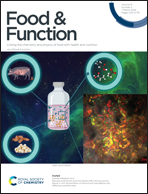The structure and potential allergenicity of peanut allergen monomers after roasting†
Abstract
Given that roasted peanut (Ro) products are commonly used in daily life, peanut allergenicity is a foremost concern. Analyzing the changes in the structure and potential allergenicity of individual allergens can promote the exploration of the structural basis of the alterations in the potential allergenicity of Ro. This work focused on four major allergens in raw peanut (Ra) and Ro. Structural changes were analyzed on the basis of circular dichroism, ultraviolet and fluorescence spectroscopy, and molecular dynamic simulation. The IgE recognition capability of allergens was assessed via western blot analysis. The IgE binding capacity of allergens was detected by conducting enzyme-linked immunosorbent assay. The potential allergenicity of allergens was evaluated using the KU812 cell degranulation model. The results showed that roasting induced different changes in the overall structures of allergens and altered the structures and electrostatic potential of IgE epitopes, especially Ara h 1 and Ara h 6. These alterations affected the potential allergenicity of allergens. Ara h 1 and Ara h 6 in Ro showed significantly enhanced IgE binding capacities and abilities to elicit KU812 cell degranulation, while Ara h 2 and Ara h 3 did not change significantly. For total protein, the roasted peanut protein showed decreased abilities to elicit KU812 cell degranulation. The results indicated that different allergens in Ro showed different changes of structures and potential allergenicity and that the conformational structure plays a crucial role in potential allergenicity of allergens.



 Please wait while we load your content...
Please wait while we load your content...